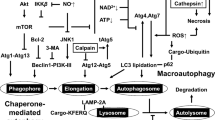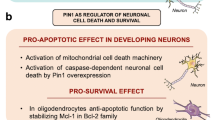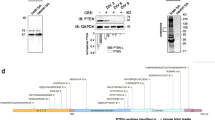Abstract
This review outlines the neuroprotective activities and structural specificities of two distinct proteins, activity-dependent neuroprotective protein, a protein assigned transcription factor/chromatin remodeling activity, and carboxypeptidase E, a classic exopeptidase. Future studies will elucidate how these two versatile proteins converge onto a similar endpoint: neuroprotection.


Similar content being viewed by others
References
Aloy, P., Companys, V., Vendrell, J., Aviles, F. X., Fricker, L. D., Coll, M., et al. (2001). The crystal structure of the inhibitor-complexed carboxypeptidase D domain II and the modeling of regulatory carboxypeptidases. Journal of Biological Chemistry, 276, 16177–16184.
Baas, D., Bumsted, K. M., Martinez, J. A., Vaccarino, F. M., Wikler, K. C., & Barnstable, C. J. (2000). The subcellular localization of Otx2 is cell-type specific and developmentally regulated in the mouse retina. Molecular Brain Research, 78, 26–37.
Bassan, M., Zamostiano, R., Davidson, A., Pinhasov, A., Giladi, E., Perl, O., et al. (1999). Complete sequence of a novel protein containing a femtomolar-activity-dependent neuroprotective peptide. Journal of Neurochemistry, 72, 1283–1293.
Beni-Adani, L., Gozes, I., Cohen, Y., Assaf, Y., Steingart, R. A., Brenneman, D. E., et al. (2001). A peptide derived from activity-dependent neuroprotective protein (ADNP) ameliorates injury response in closed head injury in mice. Journal of Pharmacology and Experimental Therapeutics, 296, 57–63.
Borozdin, W., Graham Jr., J. M., Bohm, D., Bamshad, M. J., Spranger, S., Burke, L., et al. (2007). Multigene deletions on chromosome 20q13.13-q13.2 including SALL4 result in an expanded phenotype of Okihiro syndrome plus developmental delay. Human Mutation, 28(8), 830.
Cawley, N. X., Zhou, J., Hill, J. M., Abebe, D., Romboz, S., Yanik, T., et al. (2004). The carboxypeptidase E knockout mouse exhibits endocrinological and behavioral deficits. Endocrinology, 145, 5807–5819.
Chao, M. V., Rajagopal, R., & Lee, F. S. (2006). Neurotrophin signalling in health and disease. Clinical Science (London), 110, 167–173.
Chen, S. Y., Charness, M. E., Wilkemeyer, M. F., & Sulik, K. K. (2005). Peptide-mediated protection from ethanol-induced neural tube defects. Devevelopmental Neuroscience, 27, 13–19.
Cool, D. R., Normant, E., Shen, F. S., Chen, H. C., Pannell, L., Zhang, Y., et al. (1997). Carboxypeptidase E is a regulated secretory pathway sorting receptor: Genetic obliteration leads to endocrine disorders in Cpefat mice.. Cell, 88, 73–83.
Cosgrave, A. S., McKay, J. S., Bubb, V., Morris, R., Quinn, J. P., & Thippeswamy, T. (2008). Regulation of activity-dependent neuroprotective protein (ADNP) by the NOcGMP pathway in the hippocampus during kainic acid-induced seizure. Neurobiology of Disease, 30, 281–292.
Dangoor, D., Giladi, E., Fridkin, M., & Gozes, I. (2005). Neuropeptide receptor transcripts are expressed in the rat clitoris and oscillate during the estrus cycle in the rat vagina. Peptides, 26, 2579–2584.
Divinski, I., Holtser-Cochav, M., Vulih-Schultzman, I., Steingart, R. A., & Gozes, I. (2006). Peptide neuroprotection through specific interaction with brain tubulin. Journal of Neurochemistry, 98, 973–984.
Divinski, I., Mittelman, L., & Gozes, I. (2004). A femtomolar acting octapeptide interacts with tubulin and protects astrocytes against zinc intoxication. Journal of Biological Chemistry, 279, 28531–28538.
Fricker, L. D., & Snyder, S. H. (1983). Purification and characterization of enkephalin convertase, an enkephalin-synthesizing carboxypeptidase. Journal of Biological Chemistry, 258, 10950–10955.
Furman, S., Hill, J. M., Vulih, I., Zaltzman, R., Hauser, J. M., Brenneman, D. E., & Gozes, I. (2005). Sexual dimorphism of activity-dependent neuroprotective protein in the mouse arcuate nucleus. Neuroscience Letters, 373, 73–78.
Furman, S., Steingart, R. A., Mandel, S., Hauser, J. M., Brenneman, D. E., & Gozes, I. (2004). Subcellular localization and secretion of activity-dependent neuroprotective protein in astrocytes. Neuron Glia Biology, 1, 193–199.
Fuse, N., Maiti, T., Wang, B., Porter, J. A., Hall, T. M., Leahy, D. J., et al. (1999). Sonic hedgehog protein signals not as a hydrolytic enzyme but as an apparent ligand for patched.. Proceedings of the National Academy of Sciences of the United States of America, 96, 10992–10999.
Gennet, N., Herden, C., Bubb, V. J., Quinn, J. P., & Kipar, A. (2008). Expression of activity-dependent neuroprotective protein in the brain of adult rats. Histology and Histopathology, 23, 309–317.
Gozes, I. (2007). Activity-dependent neuroprotective protein: From gene to drug candidate. Pharmacology & Therapeutics, 114, 146–154.
Gozes, I., & Divinski, I. (2004). The femtomolar-acting NAP interacts with microtubules: Novel aspects of astrocyte protection. Journal of Alzheimer’s Disease, 6, S37–S41.
Gozes, I., Divinsky, I., Pilzer, I., Fridkin, M., Brenneman, D. E., & Spier, A. D. (2003). From vasoactive intestinal peptide (VIP) through activity-dependent neuroprotective protein (ADNP) to NAP: A view of neuroprotection and cell division. Journal of Molecular Neurosciene, 20, 315–322.
Gozes, I., Morimoto, B. H., Tiong, J., Fox, A., Sutherland, K., Dangoor, D., et al. (2005a). NAP: Research and development of a peptide derived from activity-dependent neuroprotective protein (ADNP). CNS Drug Reviews, 11, 353–368.
Gozes, I., Zaltzman, R., Hauser, J., Brenneman, D. E., Shohami, E., & Hill, J. M. (2005b). The expression of activity-dependent neuroprotective protein (ADNP) is regulated by brain damage and treatment of mice with the ADNP derived peptide, NAP, reduces the severity of traumatic head injury. Current Alzheimer Research, 2, 149–153.
Hook, V. Y. (1984). Carboxypeptidase B-like activity for the processing of enkephalin precursors in the membrane component of bovine adrenomedullary chromaffin granules. Neuropeptides, 4, 117–126.
Imayoshi, I., Sakamoto, M., Ohtsuka, T., Takao, K., Miyakawa, T., Yamaguchi, M., et al. (2008). Roles of continuous neurogenesis in the structural and functional integrity of the adult forebrain. Nature Neuroscience, 11, 1153–1161.
Jacob, T. C., & Kaplan, J. M. (2003). The EGL-21 carboxypeptidase E facilitates acetylcholine release at Caenorhabditis elegans neuromuscular junctions. Journal of Neuroscience, 23, 2122–2130.
Jeffrey, K. D., Alejandro, E. U., Luciani, D. S., Kalynyak, T. B., Hu, X., Li, H., et al. (2008). Carboxypeptidase E mediates palmitate-induced beta-cell ER stress and apoptosis. Proceedings of the National Academy of Sciences of the United States of America, 105, 8452–8457.
Jin, K., Graham, S. H., Nagayama, T., Goldsmith, P. C., Greenberg, D. A., Zhou, A., et al. (2001). Altered expression of the neuropeptide-processing enzyme carboxypeptidase E in the rat brain after global ischemia. Journal of Cerebral Blood Flow & Metabolism, 21, 1422–1429.
Korte, M., Carroll, P., Wolf, E., Brem, G., Thoenen, H., & Bonhoeffer, T. (1995). Hippocampal long-term potentiation is impaired in mice lacking brain-derived neurotrophic factor. Proceedings of the National Academy of Sciences of the United States of America, 92, 8856–8560.
Lou, H., Kim, S. K., Zaitsev, E., Snell, C. R., Lu, B., & Loh, Y. P. (2005). Sorting and activity-dependent secretion of BDNF require interaction of a specific motif with the sorting receptor carboxypeptidase e. Neuron, 45, 245–255.
Mandel, S., & Gozes, I. (2007). Activity-dependent neuroprotective protein constitutes a novel element in the SWI/SNF chromatin remodeling complex. Journal of Biological Chemistry, 282(47), 34448–34456.
Mandel, S., Rechavi, G., & Gozes, I. (2007). Activity-dependent neuroprotective protein (ADNP) differentially interacts with chromatin to regulate genes essential for embryogenesis. Developmental Biology, 303, 814–824.
Mandel, S., Spivak-Pohis, I., & Gozes, I. (2008). ADNP differential nucleus/cytoplasm localization in neurons suggests multiple roles in neuronal differentiation and maintenance. Journal of Molecular Neuroscience, 35, 127–141.
Matsuoka, Y., Gray, A. J., Hirata-Fukae, C., Minami, S. S., Waterhouse, E. G., Mattson, M. P., et al. (2007). Intranasal NAP administration reduces accumulation of amyloid peptide and tau hyperphosphorylation in a transgenic mouse model of Alzheimer’s disease at early pathological stage. Journal of Molecular Neuroscience, 31, 165–170.
Nedelec, S., Foucher, I., Brunet, I., Bouillot, C., Prochiantz, A., & Trembleau, A. (2004). Emx2 homeodomain transcription factor interacts with eukaryotic translation initiation factor 4E (eIF4E) in the axons of olfactory sensory neurons. Proceedings of the National Academy of Sciences of the United States of America, 101, 10815–10820.
Niikura, T., Tajima, H., & Kita, Y. (2006). Neuronal cell death in Alzheimer’s disease and a neuroprotective factor, humanin. Current Neuropharmacology, 4, 139–147.
Park, J. J., Cawley, N. X., & Loh, Y. P. (2008a). A bi-directional carboxypeptidase E-driven transport mechanism controls BDNF vesicle homeostasis in hippocampal neurons.. Molecular and Cellular Neuroscience, 39, 63–73.
Park, J. J., Cawley, N. X., & Loh, Y. P. (2008b). Carboxypeptidase E cytoplasmic tail-driven vesicle transport is key for activity-dependent secretion of peptide hormones. Molecular Endocrinology, 22, 989–1005.
Pascual, M., & Guerri, C. (2007). The peptide NAP promotes neuronal growth and differentiation through extracellular signal-regulated protein kinase and Akt pathways, and protects neurons co-cultured with astrocytes damaged by ethanol. Journal of Neurochemistry, 103, 557–568.
Pinhasov, A., Mandel, S., Torchinsky, A., Giladi, E., Pittel, Z., Goldsweig, A. M., et al. (2003). Activity-dependent neuroprotective protein: A novel gene essential for brain formation. Developmental Brain Research, 144, 83–90.
Poggi, S. H., Vink, J., Goodwin, K., Hill, J. M., Brenneman, D. E., Pinhasov, A., et al. (2002). Differential expression of embryonic and maternal activity-dependent neuroprotective protein during mouse development. American Journal of Obstetrics and Gynecology, 187, 973–976.
Sari, Y., & Gozes, I. (2006). Brain deficits associated with fetal alcohol exposure may be protected, in part, by peptides derived from activity-dependent neurotrophic factor and activity-dependent neuroprotective protein. Brain Research Reviews, 52, 107–118.
Shetty, A. K., & Hattiangady, B. (2007). Restoration of calbindin after fetal hippocampal CA3 cell grafting into the injured hippocampus in a rat model of temporal lobe epilepsy. Hippocampus, 17, 943–956.
Sigalov, E., Fridkin, M., Brenneman, D. E., & Gozes, I. (2000). VIP-Related protection against lodoacetate toxicity in pheochromocytoma (PC12) cells: A model for ischemic/hypoxic injury. Journal of Molecular Neuroscience, 15, 147–54.
Steingart, R. A., & Gozes, I. (2006). Recombinant activity-dependent neuroprotective protein protects cells against oxidative stress. Molecular and Cellular Endocrinology, 252, 148–153.
Thippeswamy, T., Howard, M. R., Cosgrave, A. S., Arora, D. K., McKay, J. S., & Quinn, J. P. (2007). Nitric oxide-NGF mediated PPTA/SP, ADNP, and VIP expression in the peripheral nervous system. Journal of Molecular Neuroscience, 33, 268–277.
Vulih-Shultzman, I., Pinhasov, A., Mandel, S., Grigoriadis, N., Touloumi, O., Pittel, Z., et al. (2007). Activity-dependent neuroprotective protein snippet NAP reduces tau hyperphosphorylation and enhances learning in a novel transgenic mouse model. Journal of Pharmacology and Experimental Therapeutics, 323, 438–449.
Wilhelm, J. E., Hilton, M., Amos, Q., & Henzel, W. J. (2003). Cup is an eIF4E binding protein required for both the translational repression of oskar and the recruitment of Barentsz. Journal of Cell Biology, 163, 1197–1204.
Woronowicz, A., Koshimizu, H., Chang, S. Y., Cawley, N. X., Hill, J. M., Rodriguiz, R. M., et al. (2008). Absence of carboxypeptidase E leads to adult hippocampal neuronal degeneration and memory deficits. Hippocampus, 18, 1051–1063.
Yamada, M., Tanabe, K., Wada, K., Shimoke, K., Ishikawa, Y., Ikeuchi, T., et al. (2001). Differences in survival-promoting effects and intracellular signaling properties of BDNF and IGF-1 in cultured cerebral cortical neurons.. Journal of Neurochemistry, 78, 940–951.
Yamagishi, S., Yamada, M., Ishikawa, Y., Matsumoto, T., Ikeuchi, T., & Hatanaka, H. (2001). p38 mitogen-activated protein kinase regulates low potassium-induced c-Jun phosphorylation and apoptosis in cultured cerebellar granule neurons. Journal of Biological Chemistry, 276, 5129–5133.
Zaltzman, R., Alexandrovich, A., Beni, S. M., Trembovler, V., Shohami, E., & Gozes, I. (2004). Brain injury-dependent expression of activity-dependent neuroprotective protein. Journal of Molecular Neuroscience, 24, 181–187.
Zamostiano, R., Pinhasov, A., Gelber, E., Steingart, R. A., Seroussi, E., Giladi, E., et al. (2001). Cloning and characterization of the human activity-dependent neuroprotective protein. Journal of Biological Chemistry, 276, 708–714.
Zhu, X., Wu, K., Rife, L., Cawley, N. X., Brown, B., Adams, T., et al. (2005). Carboxypeptidase E is required for normal synaptic transmission from photoreceptors to the inner retina. Journal of Neurochemistry, 95, 1351–1362.
Zuccato, C., & Cattaneo, E. (2007). Role of brain-derived neurotrophic factor in Huntington’s disease.. Progress in Neurobiology, 81, 294–330.
Zusev, M., & Gozes, I. (2004). Differential regulation of activity-dependent neuroprotective protein in rat astrocytes by VIP and PACAP. Regulatory Peptides, 123, 33–41.
Acknowledgments
We would like to thank Chip Dye and Dr. Vincent Schram (Microscopy and Imaging Core, Eunice Kennedy Shriver National Institute of Child Health and Development, National Institutes of Health) for assistance with microscopic imaging and Dr. Douglas E. Brenneman for critical reading of the manuscript. This study was done in collaboration between Dr. Y. Peng Loh and Prof. Illana Gozes under the support of: The United States Israel Binational Science Foundation, the Lily and Avraham Gildor Chair for the Investigation of Growth Factors, The Adams Super Center for Brain Studies, the Dr. Diana and Zelma Elton (Elbaum) Laboratory for Molecular Neuroendocrinology, the Intramural Research Program of the Eunice Kennedy Shriver National Institute of Child Health, and Human Development and Allon Therapeutics Inc. Prof. Gozes serves as the chief Scientific Officer of Allon Therapeutics Inc.
Author information
Authors and Affiliations
Corresponding authors
Rights and permissions
About this article
Cite this article
Koshimizu, H., Senatorov, V., Loh, Y.P. et al. Neuroprotective Protein and Carboxypeptidase E. J Mol Neurosci 39, 1–8 (2009). https://doi.org/10.1007/s12031-008-9164-5
Received:
Accepted:
Published:
Issue Date:
DOI: https://doi.org/10.1007/s12031-008-9164-5




